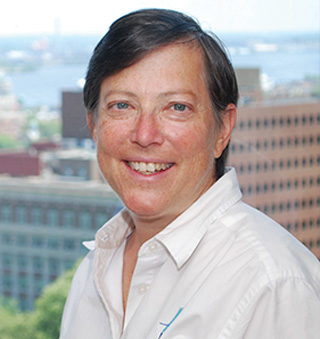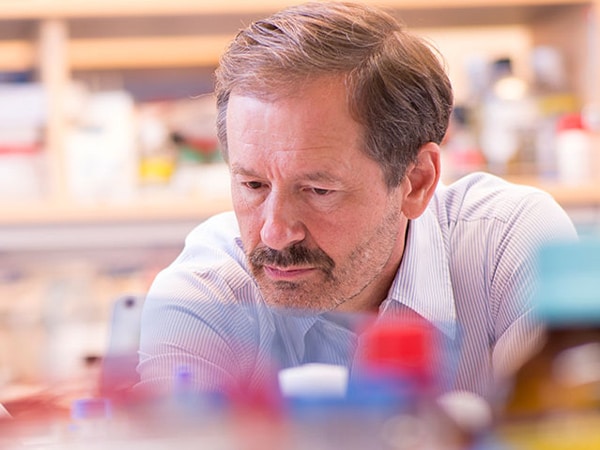Patty Klein: Supporting Increased Funding for Clinical Trials
When her ovarian cancer recurred for a third time, Patty Klein sought out a clinical trial that has kept her cancer in check for 16 months.
As a business owner, Patty Klein is always on the move, especially since her work involves a lot of travel to clients across the country. So when she noticed she’d put on 10 or 20 pounds, she wrote it off as normal middle-aged weight gain of someone in their late 40s and constantly on the go.
Then, on a trip to Orlando, Patty developed serious pain in her side. She immediately went to a local physician who suggested it might be hepatitis C, shingles, or an issue with her gallbladder. The doctor ordered an ultrasound. Patty, who had grown up in Detroit, sent it to her brother-in-law, a cardiologist in the Motor City, to look over.
“He said, “Come back to Detroit right away,”” Patty recalled. “On Saturday I had a CT scan and Monday I was diagnosed with ovarian cancer, stage 3C.”
The pain in her side was caused by a fluid buildup in her abdomen – ascites – pressing against her liver. The diagnosis stunned Patty, who been vigilant against breast cancer because her mother was diagnosed with the disease at 40.
“I was always extremely concerned about breast cancer,” she said. “I had annual mammograms and even a biopsy at one point along the way, but always was clean.”
It was after her diagnosis that she learned she was positive for the BRCA1 mutation that significantly increases the risk of both breast and ovarian cancers. As it turns out, both of Patty’s sisters and her brother also tested positive for the mutation.
“There is so much publicity about breast cancer and I never realized that it was so closely tied to ovarian cancer, particularly for those with BRCA mutations,” she said.
About a week after the diagnosis, Patty had surgery at the University of Michigan in Ann Arbor. Her surgery included a hysterectomy and tumor debulking to remove any tumors that were larger than 1 centimeter.
Following her recovery, she underwent 18 rounds of chemotherapy, including several rounds delivered directly into her abdomen. The treatment seemed to work. Patty’s medical team told her that they could find no evidence of the cancer.
Six months later, however, a blood test and a PET scan revealed that the cancer had recurred. After another six months of chemotherapy – this time a combination of taxol and carboplatin – the cancer once again seemed to be gone, but six months later it was back. After another six challenging rounds of chemotherapy with taxol, Patty once again appeared to be cancer-free.

When the cancer returned yet again, Patty sought alternative treatment options.
Her physician mentioned that clinical trials testing medications called PARP inhibitors were showing promise in patients with BRCA mutations, but then he told her that those trials were full.
At this point, Patty began doing her own research and learned very quickly that there are a lot of criteria to qualify for a clinical trial and that many were full or had waiting lists. Patty and her husband found two trials she qualified for, including one at the Dana Farber Cancer Institute in Boston. Both had waiting lists and only enrolled a small number of patients each month.
“Well here I am, facing cancer for the fourth time, I’ve got a tumor on my spleen and I want to get rid of it right away,” Patty said. “The thought of not getting into the trial right away was very, very scary to me.”
So she persisted and ultimately got a slot in the Dana Farber trial.
The trial, which was grounded in research and funding for the Stand Up To Cancer Targeting PI3K in Women’s Cancers Dream Team, was testing a combination of two medications, olaparib [Lynparza] and BKM120.
In May 2009, Stand Up To Cancer initiated its “Dream Team” initiative featuring grants to teams made up of the best basic cancer scientists and clinicians, including the Women’s Cancers Dream Team.
The AACR is the Scientific Partner of Stand Up To Cancer, providing expert peer review, grants administration, and scientific oversight to the Dream Teams and individual awardees that seek to push forward innovative cancer research.
The combination treatment is oral, so Patty takes “pills every day, which have very limited side effects. This is phenomenal because it allows me to be completely focused on work, like I’ve always been.”
For the initial eight weeks on the trial, Patty traveled to Boston each week for testing. Now, those appointments are every four weeks and alternate between blood tests and CT scans. She is qualified to remain in the trial as long as her tumor does not increase in size by more than 10 percent.
Patty is excited that she was able to find a clinical trial and that she had the wherewithal to travel to Boston for her care, although she recognizes that many people with her illness would be unable to do the same. That’s why she is so adamant that there needs to be more funding for pioneering research and to open clinical trials to more patients.
“Real hope is finding a cure for cancer by supporting research and supporting the great scientists out there that are working toward that goal. That is our hope because it’s a terrible disease, it takes people out of their life way too young at any age, and as Americans – we should be continuing to lead the progress to cure cancer.”
Read or download Patty’s story in the AACR Cancer Progress Report 2015.
The AACR was saddened to learn that Patty died since this article was published. We are deeply grateful to her for sharing her cancer experience with the AACR. We offer our heartfelt condolences to her family and friends.



